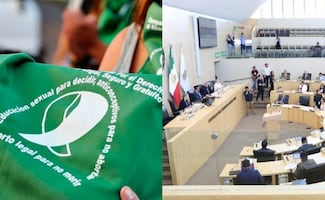Más Información

Consejo Mexicano de Negocios presenta 38 proyectos de inversión a Sheinbaum; pide menos trámites y más seguridad

Sheinbaum alista viaje a Washington y primer encuentro con Trump; así han sido sus giras internacionales como Presidenta

Por 24 horas, Ley de Aguas convierte San Lázaro en ring de acusaciones, insultos y jaloneos; así se vivió el debate

Sheinbaum invita al Zócalo capitalino este 6 de diciembre para celebrar 7 años de la 4T; "nuestro movimiento es enorme", resalta

"La Reina del Pacífico" acusa omisión de FGR en entrega de inmuebles; sobrina de Félix Gallardo reclama sus bienes desde 2014
All kinds of people, from politicians to scientists, artists, activists, ethnic groups, ex-combatants, and even an overthrown monarch, have found shelter in Mexico since the 20th century, as a result of the country's uninterrupted tradition of both political and humanitarian asylum .
Asylum in both Mexico and Latin America is consolidated, according to the Mexican Commission for Refugee Assistance (COMAR) , at a series of conventions on the subject in Havana (1928), Montevideo (1933) and Caracas (1954). Both Havana and Montevideo laid the legal foundations which led the Government of President Lázaro Cárdenas to receive Spanish Republicans —mostly intellectuals and scholars—who lost the Civil War against the Franco regime in 1937 , one of the most important waves of refugees in the history of Mexico.

It was in this framework that the Mexican port of Veracruz received on June 13, 1939 , the Sinaia ship , whose metal structure transported 1,599 Spanish migrants who fled their homeland due to the Civil War and the repression exerted by Francisco Franco.
Recommended: Asylum in Mexico: A plural tradition
On July 19, 1936 , the Spanish Army revolted against the elected government hence commencing the Civil War. In February 1939 , after three long and grueling years of fighting, Cataluña, the last remaining bastion of the Spanish Republic , was about to fall and thus began the great exodus of half a million Spanish citizens who were forced to leave their home in search of safety.

Since 1938, Félix Gordon , Spain’s ambassador in Mexico , began talking with the Mexican government in regard to an eventual migration of Spanish citizens to our country. On behalf of the Presidency, Ignacio García Téllez , Mexico’s Interior Minister, announced Mexico would give shelter to “farmworkers, professionals, and technicians who – expelled by the rebellion – had to migrate from Spain.”
The asylum granted to Spanish citizens was according to the policies of then-President Lázaro Cárdenas del Río. During the Spanish Civil War , Cárdenas denounced the violations of the non-intervention principle to the League of Nations . On Summer 1937 , Mexico welcomed almost 500 Spanish children, who were later known by History as the Children of Morelia , who were either war orphans or whose parents had taken the unbearable decision to send away to save them from the horrors of war.

Therefore, in 1939, upon knowing the subhuman conditions faced by Spanish refugees in France , Cárdenas established a generous asylum policy.
Recommended: The Children of Morelia: how Mexico gave shelter to the most innocent victims of the Spanish Civil War
Cuauhtémoc Cárdenas
has said that “the exile was a product of a war unleashed by international fascism that launched its power in support of the internal reaction that could not tolerate Spain leaving the Middle Age to flourish in a regime of equality and freedom. International fascism triumphed in Spain due to the shortsightedness and cowardice of the colonial powers of the time that sacrificed not only Spain’s people but that gave way to spill blood all over the world, their people included.”

The vessel built at Glasglow , Scottland was named Sinaia after the place where the Peles Castle is located, which is the ancient residency of the Romanian royal family and left the Sète port on May 23, 1939 , bound to the American continent. It transported people from all trades and ages who had one thing in common: They were advocates of freedom and supported the democratic government of the Second Spanish Republic . Some of the great names among the long list of Spanish exiles included the intellectuals Pedro Garfias, Tomás Segovia, Ramón Xirau, José Gaos, Eduardo Nicol, Adolfo Sánchez Vázquez, Manuel Andújar, and Benjamín Jarnés, along with the Mayo brothers who were photojournalists.
During the Sinaia’s journey across the ocean, a girl was born; she was called Susana Sinaia Caparrós in honor of the vessel, where the journal Sinaia. Diario de la Primera Expediciòn de Republicanos Españoles a Mexico was created to inform passengers of travel details, organize conferences to guide families, and share information about the country that would be their new home.

The Sinaia journal told its readers Mexico would be a temporary stop and that they should remember their objective was to “ reconquer their homeland” and thus there was no place for fighting or separatist attitudes , with which the Spanish citizens on board left their political differences aside, a situation that concerned the Mexican government for people thought their ideas could be harmful. Nevertheless, aware of the situation, the government said “the refugees will not be allowed by any means to focus on political endeavors while they live in the country.”
A chronicle about the arrival of the Sinaia to Mexico mentioned that “at 5 o'clock the Sinaia French vessel arrived in the Veracruz Bay wearing the flags of all democratic countries. On its deck, there were huge posters in which the refugees greeted Mexican people. The dock offered an unprecedented show for workers gathered from the early morning to greet from afar, with their fists raised, the Spanish refugees. This took place before dawn, with great displays of sympathy and solidarity .”

mp
Noticias según tus intereses
[Publicidad]
[Publicidad]









